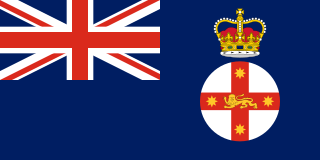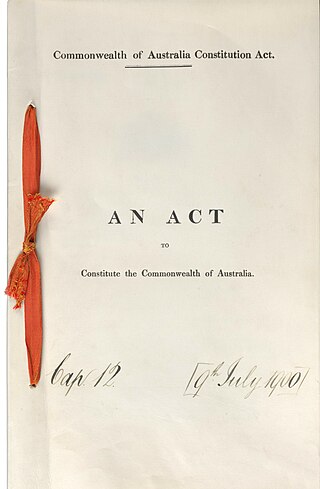Related Research Articles

The governor-general of Australia is the representative of the monarch of Australia, currently King Charles III, and performs many constitutional, ceremonial and community roles in the Australian political system. When performing these roles, the governor-general acts independently and is not the King's delegate or agent. The current governor-general is David Hurley, having been appointed on 1 July 2019. Samantha Mostyn has been chosen by Prime Minister Anthony Albanese to be the next governor-general, beginning 1 July 2024.

The governor of New South Wales is the representative of the monarch, King Charles III, in the state of New South Wales. In an analogous way to the governor-general of Australia at the national level, the governors of the Australian states perform constitutional and ceremonial functions at the state level. The governor is appointed by the monarch on the advice of the premier of New South Wales, and serves in office for an unfixed period of time—known as serving At His Majesty's pleasure—though five years is the general standard of office term. The current governor is retired judge Margaret Beazley, who succeeded David Hurley on 2 May 2019.
A head of state is the public persona of a sovereign state. The specific naming of the head of state depends on the country's form of government and separation of powers; the head of state may be a ceremonial figurehead or concurrently the head of government and more.

The governor-general of Antigua and Barbuda is the representative of the monarch of Antigua and Barbuda, currently King Charles III. The official residence of the governor-general is Government House.

The governor-general of Saint Kitts and Nevis is the representative of the monarch of Saint Kitts and Nevis, currently King Charles III. The appointed governor-general, currently Marcella Liburd, lives in Government House, Basseterre, which serves as her official residence.
In Australian constitutional law, chapter III courts are courts of law which are a part of the Australian federal judiciary and thus are able to discharge Commonwealth judicial power. They are so named because the prescribed features of these courts are contained in chapter III of the Australian Constitution.

The monarchy of Australia is a key component of Australia's form of government, embodied by the Australian sovereign and head of state. The Australian monarchy is a constitutional one, modelled on the Westminster system of parliamentary government, while incorporating features unique to the constitution of Australia.

The Cook Islands are a constitutional monarchy within the Realm of New Zealand. Under the Cook Islands Constitution, the Sovereign in Right of New Zealand has been Head of State of the Cook Islands since 4 August 1965. The Sovereign is represented by the King's Representative; as such, the King is the de jure head of state, holding several powers that are his alone, while the King's Representative is sometimes referred to as the de facto head of state. The viceregal position is currently held by Tom Marsters.
A commission is a formal document issued to appoint a named person to high office or as a commissioned officer in a territory's armed forces. A commission constitutes documentary authority that the person named is vested with the powers of that office and is empowered to execute official acts. A commission often takes the form of letters patent.

The monarchy of Jamaica is a system of government in which a hereditary monarch is the sovereign and head of state of Jamaica. The current Jamaican monarch and head of state, since 8 September 2022, is King Charles III. As sovereign, he is the personal embodiment of the Jamaican Crown. Although the person of the sovereign is equally shared with 14 other independent countries within the Commonwealth of Nations, each country's monarchy is separate and legally distinct. As a result, the current monarch is officially titled King of Jamaica and, in this capacity, he and other members of the royal family undertake public and private functions domestically and abroad as representatives of the Jamaican state. However, the monarch is the only member of the royal family with any constitutional role.

The monarchy of Barbados was a system of government in which a hereditary monarch was the sovereign and head of state of Barbados from 1966 to 2021. Barbados shared the sovereign with the other Commonwealth realms, with the country's monarchy being separate and legally distinct. The monarch's operational and ceremonial duties were mostly delegated to her representative, the governor-general of Barbados.

The monarchy of Grenada is a system of government in which a hereditary monarch is the sovereign and head of state of Grenada. The current Grenadian monarch and head of state, since 8 September 2022, is King Charles III. As sovereign, he is the personal embodiment of the Grenadian Crown. Although the person of the sovereign is equally shared with 14 other independent countries within the Commonwealth of Nations, each country's monarchy is separate and legally distinct. As a result, the current monarch is officially titled King of Grenada and, in this capacity, he and other members of the royal family undertake public and private functions domestically and abroad as representatives of Grenada. However, the King is the only member of the royal family with any constitutional role.

The monarchy of Papua New Guinea is a system of government in which a hereditary monarch is the sovereign and head of state of Papua New Guinea. The current Papua New Guinean monarch and head of state, since 8 September 2022, is King Charles III. As sovereign, he is the personal embodiment of the Papua New Guinean Crown. Although the person of the sovereign is equally shared with 14 other independent countries within the Commonwealth of Nations, each country's monarchy is separate and legally distinct. As a result, the current monarch is officially titled King of Papua New Guinea and, in this capacity, he and other members of the royal family undertake public and private functions domestically and abroad as representatives of Papua New Guinea. However, the King is the only member of the royal family with any constitutional role.

The monarchy of Tuvalu is a system of government in which a hereditary monarch is the sovereign and head of state of Tuvalu. The current Tuvaluan monarch and head of state since 8 September 2022 is King Charles III. As sovereign, he is the personal embodiment of the Tuvaluan Crown. Although the person of the sovereign is equally shared with 14 other independent countries within the Commonwealth of Nations, each country's monarchy is separate and legally distinct. As a result, the current monarch is officially titled King of Tuvalu and, in this capacity, he and other members of the royal family undertake public and private functions domestically and abroad as representatives of the Tuvaluan state. However, the King is the only member of the royal family with any constitutional role.

The Constitution of Australia is the fundamental law that governs the political structure of Australia. It is a written constitution, that establishes the country as a federation under a constitutional monarchy governed with a parliamentary system. Its eight chapters sets down the structure and powers of the three constituent parts of the federal level of government: the Parliament, the executive government and the judicature.
At His Majesty's pleasure, sometimes abbreviated to the King's pleasure, is a legal term of art referring to the indeterminate or undetermined length of service of certain appointed officials or the indeterminate sentences of some prisoners. It is based on the proposition that certain government officials are appointed by the Crown and can be removed for policy reasons, unlike employees. Originating in the United Kingdom, the phrase is now used throughout the Commonwealth realms, Lesotho, Eswatini, Brunei, and other monarchies, such as Spain, the Netherlands, and Oman. In realms where the monarch is represented by a governor-general, governor, or administrator, the phrase may be modified to be at the governor's pleasure or variations thereof, since the governor-general, governor, lieutenant governor, or administrator is the king's personal representative in the country, state, or province.
The Australian head of state dispute is a debate as to who is considered to be the head of state of Australia—the monarch, the governor-general, or both. "Head of state" is a description used in official sources for the monarch, but the Australian constitution does not mention the term. In discussion it has been used for describing the person who holds the highest rank among the officers of government. A number of writers, most notably Sir David Smith, have argued that the term is better used to describe the governor-general. The difference of opinion has mainly been discussed in the context of Australia becoming a republic, and was prominently debated in the lead-up to the republic referendum in 1999.
Chapter II of the Constitution of Australia establishes the executive branch of the Commonwealth of Australia. It provides for the exercise of executive power by the Governor-General of Australia advised by a Federal Executive Council.

From 1947 to 1956, the Dominion of Pakistan was a self-governing country within the Commonwealth of Nations that shared a monarch with the United Kingdom and the other Dominions of the Commonwealth. The monarch's constitutional roles in Pakistan were mostly delegated to a vice-regal representative, the governor-general of Pakistan.

From 1960 to 1963, Nigeria was a sovereign state and an independent constitutional monarchy. Nigeria shared the monarch with Australia, Canada, United Kingdom, and certain other sovereign states. The monarch's constitutional roles were mostly delegated to the governor-general of Nigeria.
References
- ↑ "Governor-General of the Commonwealth of Australia". National Museum of Australia. 2007. Archived from the original on 29 August 2007. Retrieved 3 September 2007.